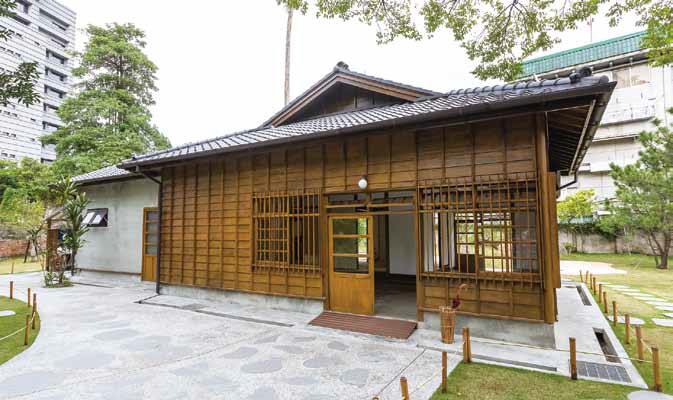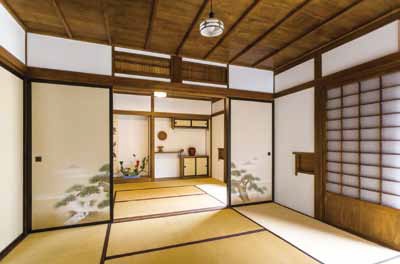 With over a century of history, the Taipei Botanical Garden is home to more than 1,600 kinds of plants. Quiet and tranquil, it is a treasured green oasis away from the city bustle. Beside the tranquil lotus pond is a bungalow-style wooden structure built during the Japanese era. After Taiwan was returned to Chinese rule in 1945, it was used for a time as a staff quarters by the Executive Yuan Council of Agriculture’s Forestry Research Institute (行政院農委會林業試驗所), but was eventually abandoned, and allowed to decay. The institute has now thoroughly renovated the building, reproducing the elegant style of the Japanese garden, and in accordance with Japanese-period cadastral information has renamed it Nanmon-cho 323 (南門町三二三).
With over a century of history, the Taipei Botanical Garden is home to more than 1,600 kinds of plants. Quiet and tranquil, it is a treasured green oasis away from the city bustle. Beside the tranquil lotus pond is a bungalow-style wooden structure built during the Japanese era. After Taiwan was returned to Chinese rule in 1945, it was used for a time as a staff quarters by the Executive Yuan Council of Agriculture’s Forestry Research Institute (行政院農委會林業試驗所), but was eventually abandoned, and allowed to decay. The institute has now thoroughly renovated the building, reproducing the elegant style of the Japanese garden, and in accordance with Japanese-period cadastral information has renamed it Nanmon-cho 323 (南門町三二三).
To repair the dilapidated main building, the Forestry Research Institute invited two internationally renowned architects, Kuo Chungrui (郭中端) and Horigome Kenji, to come together as a team. According to Kuo, many historical documents show that the grounds of the Taipei Botanical Garden were often used as a key site for the staging of expositions by the Japanese during the occupation period, and that in its early days Nanmon-cho 323 served as a teahouse where guests were received. Therefore, the building’s design and construction was very different from the standard Japanese house. Professor Horigome, who is from Japan, is an expert in traditional Japanese wood architecture. Conducting research on the original structure and appearance, he and Kuo were able to rebuild and restore the building where needed to recreate its original appearance. Walk in the front entrance and you can inspect what is called shoin-zukun design: the doma, a space for household life with central and adjoining rooms, separated by fusuma, sliding panels of thick paper that act as doors. There is also an interior zashiki, a sitting room or parlor for entertaining guests, and a drawing room,  where you can get a good feel for how visitors were received during the Japanese era.
where you can get a good feel for how visitors were received during the Japanese era.
The Forestry Research Institute also invited wellknown Japanese garden-landscaping master Oguchi Motomi, from Nagano, to create a Zen garden in the inimitable karesansui garden style, perhaps Japan’s most representative. Such gardens are considered “Zen” because they seek “emptiness” at their core, using coniferous plants. The gravel garden landscaping is sculpted using a handheld wooden rake, and the raking motions are highly practiced, almost as if in slow-motion, with the curving raked lines said to reflect the wave-like emotions of the soul. It is said that this style helps purify and heal the souls of visitors otherwise immersed in the fast, disconcerting pace of modern life.
In the subtle, minimalist outdoor-garden design, rocks are symbolic of mountains, while the raked gravel represents flowing water. While savoring the Eastern Zen ambience, visitors should look for another special touch, the small “turtle” and “crane” islands floating amidst the faux waters. These animals – and thus the islands – symbolize longevity. Oguchi’s hope is that when visitors spend time in his karesansui garden they’ll feel as though in a celestial realm, able to calm their spirits through the ethereal tranquility of Japanese Zen Buddhism.
 Nanmon-cho 323 is hidden away in Taipei Botanical Garden. The black-tinted Japanese structure, surrounding emerald-green foliage, and snow-white gravel all contrast compellingly with each other, exuding a sense of tranquility. Come here on a winter afternoon and soak in this place’s proud old character. Make time to also visit the nearby Guest House of Imperial Envoys (欽差行臺), a city heritage site, and the National Museum of History (國立歷史博物館), and enjoy these examples of Taipei’s rich cultural inheritance.
Nanmon-cho 323 is hidden away in Taipei Botanical Garden. The black-tinted Japanese structure, surrounding emerald-green foliage, and snow-white gravel all contrast compellingly with each other, exuding a sense of tranquility. Come here on a winter afternoon and soak in this place’s proud old character. Make time to also visit the nearby Guest House of Imperial Envoys (欽差行臺), a city heritage site, and the National Museum of History (國立歷史博物館), and enjoy these examples of Taipei’s rich cultural inheritance.
| Information |
Taipei Botanical Garden – Nanmon-cho 323 台北植物園──南門町三二三
Add: 53, Nanhai Rd. (南海路53號)
Tel: (02)2303-9978 ext. 1420
Time: 09:30~16:00,15 visitors allowed in every 30 minutes (closed on Mon) |
| About Nanmon-cho 323 |
- Nanmon-cho 323 is a bungalow-style wooden structure built during the Japanese era. After the renovation by the Executive Yuan Council of Agriculture’s Forestry Research Institute, it has reproduced the elegant style of the Japanese garden.
- The interior includes zashiki, a sitting room or parlor for entertaining guests, and a drawing room, where you can get a good feel for how visitors were received during the Japanese era.
- When visiting here, the tourists will experience not only the spirit of mountains and flowing water, but also the ambience of Eastern Zen.
- The small “turtle” and “crane” islands in Zen garden, designed by well-known Japanese garden-landscaping master Oguchi Motomi, symbolize longevity.
- The black-tinted Japanese structure is hidden away in Taipei Botanical Garden, the treasured green oasis full of quietness and natural ecology.
|
 With over a century of history, the Taipei Botanical Garden is home to more than 1,600 kinds of plants. Quiet and tranquil, it is a treasured green oasis away from the city bustle. Beside the tranquil lotus pond is a bungalow-style wooden structure built during the Japanese era. After Taiwan was returned to Chinese rule in 1945, it was used for a time as a staff quarters by the Executive Yuan Council of Agriculture’s Forestry Research Institute (行政院農委會林業試驗所), but was eventually abandoned, and allowed to decay. The institute has now thoroughly renovated the building, reproducing the elegant style of the Japanese garden, and in accordance with Japanese-period cadastral information has renamed it Nanmon-cho 323 (南門町三二三).
With over a century of history, the Taipei Botanical Garden is home to more than 1,600 kinds of plants. Quiet and tranquil, it is a treasured green oasis away from the city bustle. Beside the tranquil lotus pond is a bungalow-style wooden structure built during the Japanese era. After Taiwan was returned to Chinese rule in 1945, it was used for a time as a staff quarters by the Executive Yuan Council of Agriculture’s Forestry Research Institute (行政院農委會林業試驗所), but was eventually abandoned, and allowed to decay. The institute has now thoroughly renovated the building, reproducing the elegant style of the Japanese garden, and in accordance with Japanese-period cadastral information has renamed it Nanmon-cho 323 (南門町三二三). where you can get a good feel for how visitors were received during the Japanese era.
where you can get a good feel for how visitors were received during the Japanese era. Nanmon-cho 323 is hidden away in Taipei Botanical Garden. The black-tinted Japanese structure, surrounding emerald-green foliage, and snow-white gravel all contrast compellingly with each other, exuding a sense of tranquility. Come here on a winter afternoon and soak in this place’s proud old character. Make time to also visit the nearby Guest House of Imperial Envoys (欽差行臺), a city heritage site, and the National Museum of History (國立歷史博物館), and enjoy these examples of Taipei’s rich cultural inheritance.
Nanmon-cho 323 is hidden away in Taipei Botanical Garden. The black-tinted Japanese structure, surrounding emerald-green foliage, and snow-white gravel all contrast compellingly with each other, exuding a sense of tranquility. Come here on a winter afternoon and soak in this place’s proud old character. Make time to also visit the nearby Guest House of Imperial Envoys (欽差行臺), a city heritage site, and the National Museum of History (國立歷史博物館), and enjoy these examples of Taipei’s rich cultural inheritance.
![Taiwan.gov.tw [ open a new window]](/images/egov.png)
